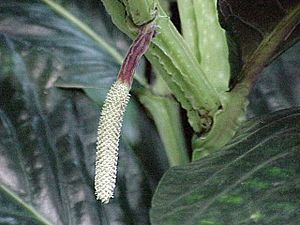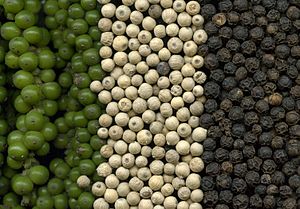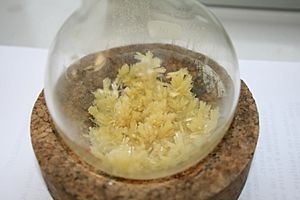Pepper plants facts for kids
Quick facts for kids Pepper plants |
|
|---|---|
 |
|
| Lacquered pepper (P. magnificum) inflorescence | |
| Scientific classification |
|
| Kingdom: | Plantae |
| Clade: | Tracheophytes |
| Clade: | Angiosperms |
| Clade: | Magnoliids |
| Order: | Piperales |
| Family: | Piperaceae |
| Subfamily: | Piperoideae |
| Genus: | Piper L. |
| Species | |
|
1000–2000; see list |
|
| Synonyms | |
|
|
Piper, also known as pepper plants or pepper vines, is a very important group of plants. It belongs to the plant family called Piperaceae. This group includes many different types of plants.
There are about 1,000 to 2,000 different species of Piper. These plants can be shrubs, small herbs, or lianas (climbing vines). Many Piper species are very common in their natural homes.
Pepper plants are part of a larger group called magnoliids. These are flowering plants but are different from monocots or eudicots. The Piperaceae family is closely related to the lizardtail family (Saururaceae). Both families have unique tail-shaped flower clusters called inflorescences. Another close relative in the same family is the Peperomia genus, often called radiator plants.
The scientific name Piper and the common name "pepper" come from an old Sanskrit word, pippali. This word was used for the long pepper (P. longum).
Contents
Where Do Pepper Plants Grow?
Piper species grow all over the tropical parts of the world. They are often found growing under taller trees in tropical forests. You can also find them in open areas or in higher places like cloud forests.
One special species, the Japanese Pepper (P. kadsura), grows in subtropical areas. It can even handle a little bit of frost in winter. Many Piper species are very common where they grow.
Most Piper plants are either herbs or vines. Some grow as shrubs or even small trees. A few species, called "ant pipers," have a special partnership with ants. This is called mutualism.
The fruit of the Piper plant is usually round and pea-sized. We call it a peppercorn. Birds are the main way these fruits spread in nature. Small fruit-eating mammals, like some bats, also help spread the seeds. Pepper plants have chemicals that protect them from animals that eat plants (herbivores). However, some insects, like certain moths and flea beetles, have learned to eat them anyway. These beetles can sometimes be a problem for pepper farmers.
How Humans Use Piper Plants
Many pepper plants are beautiful and make great ornamental plants for gardens. This is true in subtropical or warmer areas. Some pepper vines can climb like ivy. Others, like lacquered pepper (P. magnificum), grow into attractive shrubs with shiny leaves. Smaller species, like Celebes pepper (P. ornatum), are good for growing indoors in pots.
Unfortunately, cutting down too many trees in tropical forests threatens some Piper species. We don't know the full impact of this habitat destruction. But in Ecuador, over a dozen species are close to extinction. On the other hand, some Piper species, like spiked pepper (P. aduncum), have spread widely because of human activity. They can become invasive species in new areas.
The most important way humans use Piper plants is not for their looks. It's for the many strong chemicals found in their fruits.
Pepper as a Spice and Food
People have used pepper plants in cooking for a very long time. Evidence suggests it might go back as far as 9,000 years ago. Peppercorns were found in ancient food remains in Thailand. It's likely these plants were gathered from the wild.

Green (pickled unripe fruits)
White (dried ripe seeds)
Black (dried unripe fruits)
Using peppercorns as a spicy flavor is important worldwide. By ancient Roman times, there was a big spice trade of black pepper (P. nigrum) from South Asia to Europe. An old Roman cookbook from around 400 AD mentions pepper as a spice for most main dishes. In the late Roman Empire, black pepper was expensive but used more often than salt or sugar.
During the Early Middle Ages, trade routes became difficult. The use of pepper decreased a bit. But peppercorns were easy to store and valuable, so they remained a profitable trade item. In the Middle Ages, international traders were even nicknamed "pepper-sacks" in Germany. Later, European countries fought wars over control of the spice supply, especially black pepper. Today, black pepper, in its three forms (green, white, and black), is one of the most used spices from plants around the world.
Because Piper grows in many places, the fruits of other species are also important spices. Long pepper (P. longum) is perhaps the second most popular Piper spice. It has a chili-like "heat." The whole flower cluster is used because the fruits are tiny. Cubeb (P. cubeba), also called tailed pepper, was also a big part of the spice trade. It is still an important spice around the Indian Ocean today. West African pepper (P. guineense) is common in West African cuisine. It is also used in the East African berbere spice mix.
Not only the seeds of Piper are used in cooking. West African Pepper leaves, called uziza, are used to flavor stews in Nigeria. In Mexican cooking, hoja santa or Mexican pepperleaf (P. auritum) has many uses. In Southeast Asia, leaves of two Piper species are very important: lolot (P. lolot) is used to wrap meat for grilling. Wild betel (P. sarmentosum) is eaten raw or cooked as a vegetable in Malay and Thai cuisine. The stems and roots of Piper chaba are used as a spice in Bangladeshi cuisine.
Pepper Plants in Medicine
Cubeb (P. cubeba) has been used in traditional medicine and herbal remedies. In the early 1900s, it was even used to flavor cigarettes. P. darienense is used as medicine by the Kuna people near the Panama-Colombia border. Spiked pepper, often called matico, seems to have strong disinfectant and antibiotic properties.
Black pepper (P. nigrum) essential oil is sometimes used in herbal medicine. Long pepper (P. longum) is used in Ayurveda, an ancient Indian medicine system. It was an ingredient in special pills used for rejuvenating the body.
One Piper species is widely used as a stimulant. Betel (P. betle) leaves are used to wrap slices of betel palm nut. The leaf's sap helps release the stimulating effect of these "cookies," known as pan in India.
Another Piper species, kava (P. methysticum), is used for its relaxing and mood-lifting effects. It is often prepared as a traditional drink.
Why Scientists Study Piper
The Piper genus is great for studying many scientific topics. These include natural history, how living things work at a tiny level (molecular biology), and the chemicals found in plants. Scientists also study how different living things interact (community ecology) and how plants change over time (evolutionary biology).

.
Piper is a "model genus" for research in ecology and evolution. Its many different species and importance in nature make it perfect for these studies. Most research has focused on black pepper (P. nigrum), kava (P. methysticum), and betel (P. betle). Recent studies suggest that black pepper first grew in India.
The special partnerships between some Piper species and ants are also studied. These partnerships greatly affect the plants' lives. They are ideal for learning about how different species work together (symbioses) and how these relationships affect communities of living things.
Important chemicals found in pepper plants include piperine and chavicine. These were first found in black pepper. They are known to have properties that fight bacteria. For example, early research shows piperine can fight bacteria like S. aureus and Helicobacter pylori. The chemical group piperidine is named after piperine.
The main chemicals in kava are kavalactones and flavokawains. Another chemical, pipermethystine, is thought to be the main compound that affects the liver in kava's stems and leaves.
Types of Piper Species
Most Piper species are found in the Americas (about 700 species). About 300 species come from Southern Asia. There are smaller groups in the South Pacific (about 40 species) and Africa (about 15 species). The groups from the Americas, Asia, and the South Pacific seem to be related through a single ancestor. The relationships of the African species are not as clear.
Some species are sometimes placed in separate groups like Pothomorphe or Macropiper. However, many experts prefer to keep them all within the Piper genus.
The plants sometimes called "Piper aggregatum" and "P. fasciculatum" are actually a different plant called Lacistema aggregatum. This plant belongs to a different family.
See also
 In Spanish: Piper para niños
In Spanish: Piper para niños


